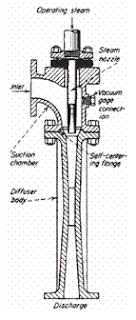A pump is a physical contrivance that is used to deliver fluids from one location to another through conduits. Over the years, numerous pump designs have evolved to meet differing requirements. The basic requirements to define the application are suction and delivery pressures, pressure loss in transmission, and the flow rate. Special requirements may exist in food, pharmaceutical, nuclear, and other industries that impose material selection requirements of the pump. The primary means of transfer of energy to the fluid that causes flow are gravity, displacement, centrifugal force, electromagnetic force, transfer of momentum, mechanical impulse, and a combination of these energy-transfer mechanisms. Gravity and centrifugal force are the most common energy-transfer mechanisms in use.
Pump designs have largely been standardized. based on application experience, numerous standards have come into existence. As special projects and new application situations for pumps develop, these standards will be updated and revised. Common pump standards are:
1. American Petroleum Institute (API) Standard 610, Centrifugal Pumps for Refinery Service.
2. American Waterworks Association (AWWA) E101, Deep Well Vertical Turbine Pumps.
3. Underwriters Laboratories (UL) UL 51, UL343, UL1081, UL448, UL1247.
4. National Fire Protection Agency (NFPA) NFPA-20 Centrifugal Fire Pumps.
5. American Society of Mechanical Engineers (ASME).
6. American National Standards Institute.
7. Hydraulic Institute Standards (Application).
These standards specify design, construction, and testing details such as material selection, shop inspection and tests, drawings and other uses required, clearances, construction procedures, and so on.
The most common types of pumps used in chemical plant are centrifugal and positive displacement. Occasionally regenerative turbine pumps, axial-flow pumps, and ejectors are used.
Modern practice is to use centrifugal rather than positive displacement pumps where possible because they are usually less costly, require less maintenance, and less space. Conventional centrifugal pumps operate at speeds between 1200 and 8000 rpm. Very high speed centrifugal pumps, which can operate up to 23,000 rpm and higher, are used for low-capacity, highhead applications. Most centrifugal pumps will operate with an approximately constant head over a wide range of capacity.
Positive displacement pumps are either reciprocating or rotary. Reciprocating pumps include piston, plunger, and diaphragm types. Rotary pumps are: single lobe, multiple lobe, rotary vane, progressing cavity, and gear types. Positive displacement pumps operate with approximately constant capacities over wide variations in head, hence they usually are installed for services which require high heads at moderate capacities. A special application of small reciprocating pumps in gas processing plants is for injection of fluids (e.g. methanol and corrosion inhibitors) into process streams, where their constant-capacity characteristics are desirable.
Axial-flow pumps are used for services requiring very high capacities at low heads. Regenerative-turbine pumps are used for services requiring small capacities at high heads. Ejectors are used to avoid the capital cost of installing a pump, when a suitable motive fluid (frequently steam) is available, and are usually low-efficiency devices. These kinds of pumps are used infrequently in the gas processing industry.
To properly accomplish a good and thorough ratinghizing of a centrifugal pump, the plant system designer should at a minimum do the following.
1. Understand the fundamentals of performance of the pump itself.
2. Understand the mechanical details required for a pump to function properly in a system.
3. Calculate the friction and any other pressure losses for each "side" of the pump, suction, and discharge.
4. Determine the suction side and discharge side heads for the mechanical system connecting to the pump.
5. Determine the important available net positive suction head (NPSH,) for the pump suction side mechanical system, and compare this to the manufacturer's required net positive suction head (NPSH,) by the pump itself. This requires that the designer makes a tentative actual pump selection of one or more manufacturers in order to use actual numbers.
6. Make allowable corrections to the pump's required NPSH (using charts where applicable) and compare with the available NPSH. The available must always be several feet (mm) greater than the corrected required.
7. Make fluid viscosity corrections to the required performance if the fluid is more viscous than water.
8. Examine specific speed index, particularly if it can be anticipated that future changes in the system may be required.
9. If fluid being pumped is at elevated temperature (usually above 90o F (32.2o C )), check temperature rise in the pump and the minimum flow required through the pump.
10. Make pump brake horsepower corrections for fluids with a specific gravity different from water. Select actual driver (electric motor, usually) horsepower in order that horsepower losses between the driver and the pump shaft will still provide sufficient power to meet the pump's input shaft requirements.
11. If the pump has some unique specialty service or requirements, recognize these in the final sizing and selection. Consult a reliable manufacturer that produces pumps for the type of service and applications and have them verify the analysis of your system's application.








